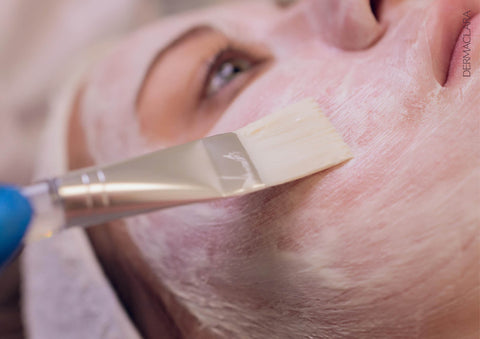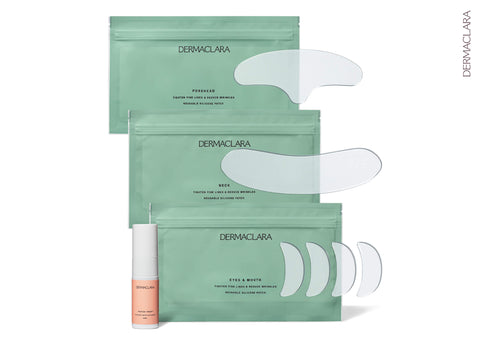What Is a Chemical Peel?

A chemical peel is a cosmetic procedure designed to rejuvenate the skin by removing the outer layers. This process involves applying a chemical solution to the skin, which causes it to exfoliate and eventually peel off. The result is smoother, brighter skin with improved texture and tone.
What Is the Chemical Peel Process?
Think of a chemical peel as a mini-reset button for your skin! During a facial appointment, your skincare professional will clean your skin and apply the peel solution. After a little while, they rinse it off, revealing the brand-new skin hiding underneath.
Do Chemical Peels Hurt?
Okay, let's address the big question: does it hurt? Well, not really! You might feel a bit of tingling or warmth as the solution does its thing, but it's totally manageable. Most folks find it more like a spa treatment than a painful procedure. Plus, your skincare expert will be right there to make sure you're comfortable every step of the way.
Chemical Peel Benefits for Your Skin
Chemical peels have so many benefits, from fading acne scars to reducing wrinkles. Below, we break it down.
Chemical Peel for Acne Scars
Acne scars can be stubborn and frustrating, but chemical peels come to the rescue. By exfoliating the top layer of your skin, chemical peels help fade acne scars over time, revealing a more even complexion underneath. With consistent treatments, you can significantly reduce the appearance of acne scars.
Chemical Peel for Hyperpigmentation
Hyperpigmentation, or uneven skin tone, can be caused by sun damage, hormonal changes, or inflammation. Fortunately, chemical peels can help even out your skin tone by targeting the excess pigment in your skin.
Chemical Peel for Melasma
Melasma is a common skin condition characterized by patches of dark pigmentation, often triggered by hormonal changes or sun exposure. While melasma can be challenging to treat, chemical peels can help lighten the pigmented areas and improve overall skin tone.
Chemical Peel for Wrinkles
Chemical peels can help reduce the appearance of fine lines and wrinkles by stimulating collagen production and promoting skin renewal. Whether you're looking to smooth out crow's feet, forehead lines, or smile lines, chemical peels offer a non-invasive solution for achieving younger-looking skin.
Chemical peels for the face clearly have so many benefits! Be sure to chat with a skincare expert about what you want to target and how often you should go in for treatment. And, no matter what, make sure your esthetician documents your journey. You won’t believe the chemical peel before and after photos!

Types of Chemical Peels
When it comes to chemical peels, there's no one-size-fits-all solution. Various types of peels are available, each offering unique benefits and targeting different skin concerns.
- Superficial Peels: These gentle peels primarily exfoliate the outer layer of the skin. They improve skin texture, reduce fine lines, and treat mild discoloration.
- Medium Peels: Medium-depth peels penetrate deeper into the skin, targeting moderate skin imperfections like deeper wrinkles, acne scars, and uneven pigmentation.
- Deep Peels: Deep peels provide more dramatic results by penetrating the middle layer of the skin. They effectively treat severe wrinkles, deep scars, and significant sun damage. However, they require more downtime and carry a higher risk of side effects.
Your skincare professional will help determine the most suitable chemical peel for your skin type and concerns.
How Long Does a Chemical Peel Take to Heal
The healing time after a chemical peel depends on several factors, including the type and strength of the peel and your skin's natural healing process.
Heal Time for Superficial Peels
Typically, superficial peels involve minimal downtime. Although your skin may appear slightly red or flaky for a few days, you can usually resume your regular activities immediately.
Heal Time for Medium Peels
Medium-depth peels require more downtime. Redness, swelling, and peeling lasting up to a week or more.
Heal Time for Deep Peels
Deep peels have the longest recovery time, with significant peeling and redness lasting several weeks. It's essential to follow your skincare professional's post-procedure instructions carefully to ensure proper healing and minimize complications.
Chemical Peel Aftercare Tips
After undergoing a chemical peel, proper aftercare is essential to ensure optimal results and minimize potential side effects. Follow our tips below to get the most out of your peel.
Tip #1: Protect Your Skin from the Sun
Sun exposure can worsen post-peel redness and increase the risk of hyperpigmentation. Wear sunscreen daily and avoid prolonged sun exposure, especially during the healing process.
Tip #2: Keep Your Skin Moisturized
Apply a gentle, hydrating moisturizer regularly to soothe dryness and prevent excessive peeling.
Tip #3: Apply Dermaclara Face Patches
Dermaclara silicone patches provide a protective barrier over the skin, helping to lock in moisture, promote healing, and prevent irritation–making them perfect for chemical peel aftercare. After cleansing, apply Dermaclara to the treated area. Leave them on for 15 minutes or wear them overnight, and gently remove them once done. Incorporating Dermaclara into your chemical peel aftercare routine can help enhance results and promote a smoother, more radiant complexion.

Tip #4: Avoid Harsh Skincare Products
To prevent irritation, skip abrasive scrubs, retinoids, and other harsh skincare products until your skin has fully healed.
Tip #5: Stay Hydrated and Eat Well
Drink plenty of water and eat a balanced diet rich in fruits, vegetables, and antioxidants to support your skin's natural healing process.
How Long Does a Chemical Peel Last
The duration of results from a chemical peel can vary depending on factors such as the peel type, skin type, and skincare routine. Generally, superficial peels may provide results that last several weeks to a few months, while deeper peels can offer more long-lasting results lasting up to a year or more.
How Often Should You Get a Chemical Peel
The frequency of chemical peel treatments depends on your skin's condition and desired outcomes. For most people, a series of treatments several weeks apart achieves optimal results. After that, maintenance treatments may be scheduled every few months to maintain the benefits of the peel. It's essential to consult with your skincare professional to develop a personalized treatment plan tailored to your skin's needs and goals.
Microneedling vs Chemical Peel
Don’t get confused! Microneedling and chemical peels are both treatments for your skin, but they do different things. Microneedling uses tiny needles to make small injuries in your skin, which helps make it look better by producing more collagen. Chemical peels, on the other hand, use a special solution to remove dead skin cells and reveal smoother skin underneath.
Choosing between microneedling and chemical peels depends on what you want to improve about your skin. Microneedling is good for making your skin smoother and reducing fine lines, while chemical peels can help with things like acne scars, uneven skin tone, and dark spots. Your skincare professional can help you decide which one is best for you.
Chemical Peel vs Microdermabrasion
Same thing here! Chemical peels and microdermabrasion are both ways to make your skin look better, but they work a bit differently. Microdermabrasion gently removes the top layer of your skin using a special tool, while chemical peels use a solution to do a deeper cleaning.
Chemical peels can treat more skin problems, such as wrinkles, acne scars, and dark spots, while microdermabrasion is gentler and might be better for sensitive skin. Your skincare pro can help you determine which is right for you.
How Much Is a Chemical Peel
Chemical peel cost can vary depending on where you get it done and what kind you choose. On average, one session might cost between $150 and $300. You might also have to pay for other things like a consultation or special products before and after the treatment.
It's important to talk to a skincare professional about what you want to achieve and how much you're willing to spend. While a chemical peel might seem pricey, many people think it's worth it for the results—a smoother, more glowing complexion.
Can You Do a Chemical Peel at Home?
So the cost is a little higher than you expected, and now you are thinking, “Can I DIY this?” The answer is sort of, but with major caution. At-home chemical peel products contain strong acids that can harm your skin if used incorrectly. Before trying one, talk to a skincare expert. But for the safest and most effective results, consider getting a peel done by a professional who can give you personalized advice and supervision.
Where to Find the Perfect Chemical Peel Near Me?
Finding the right place for a chemical peel is key. Look for skincare clinics or spas with experienced professionals and positive reviews in your area. Ask friends or check online for recommendations. Consider scheduling consultations with different providers to discuss your goals.
You are now ready to go forth and peel off your face responsibly! Just follow everything we laid out and talk to a skincare professional before taking any steps forward.
Leave a comment